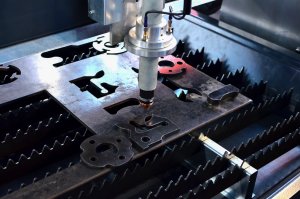Introduction to Alloy Steel and Stainless Steel
An alloy is a combination of metals or a metal mixed with one or more elements, engineered to enhance material properties such as strength, durability, corrosion resistance, and much more. These improved characteristics are pivotal in material science where the performance of materials under various conditions is paramount. The distinct comparison between alloy steel—a blend primarily of iron and carbon with added elements—and stainless steel, known for its significant chromium content which bestows lustrous appearance and impressive corrosion resistance, exemplifies the targeted applications and benefits that specific alloys can offer. By contrasting these two steel types, we unveil insights into their composition, mechanics and uses within industry sectors.
Defining Alloy Steel
Alloy steel is a blend of iron with various metals and non-metals that enhance its properties for specific applications. By incorporating elements such as manganese, chromium, and nickel, manufacturers tailor the material’s characteristics to suit particular demands. Manganese increases strength and wear resistance while aiding in steel deoxidation; chromium boosts hardness, corrosion resistance, and toughness; and nickel contributes to overall strength and corrosion resistance without significantly altering the steel’s ductility. These alloying components are chosen based on the required mechanical and physical properties for products ranging from construction beams to automotive parts, ensuring alloy steels are versatile materials suitable for a wide array of industrial uses.
Defining Stainless Steel
Stainless steel stands apart as a highly valued material, renowned for its exceptional resistance to corrosion which primarily stems from its chromium content. This key element forms an invisible and adherent chromium-rich oxide layer on the steel’s surface, shielding it from water and air that could initiate corrosive processes. Typically, stainless steel comprises at least 10.5% chromium by mass alongside iron and other alloying elements like nickel, molybdenum, or titanium, enhancing properties such as formability and strength. Owing to these characteristics, stainless steel finds widespread use across numerous fields including architecture for cladding, automotive industry for exhaust systems, medical instruments due to stringent hygiene standards, as well as kitchen utensils and appliances because of their easy cleaning ability and aesthetic appeal.
Key Differences Between Alloy Steel and Stainless Steel
The composition of alloy steel includes varying elements such as manganese, silicon, nickel, and copper, which provide specific properties like strength and hardness. In contrast, stainless steel is defined by its high chromium content—at least 10.5%—which bestows superior corrosion resistance. Durability-wise, stainless steels are generally more resistant to rusting and staining compared to alloy steels, making them preferable in environments prone to corrosion. From a cost perspective, alloy steels tend to be less expensive due to the lower quantities of pricey alloys like nickel and chromium; thus, they’re widely used for bulk applications where corrosion is not a primary concern. When considering practical applications, stainless steel’s resilience against environmental factors makes it suitable for medical instruments or food-grade containers, while alloy steel is often utilized in automotive components and construction projects because of its high tensile strength and durability despite being less resistant to corrosive elements.
Pros and Cons of Using Alloy Steel
Alloy steel offers a balance between cost-effectiveness and mechanical properties, which includes its high tensile strength and toughness. Being highly customizable with various elements like manganese, nickel, chromium, or vanadium can enhance specific characteristics like hardness and corrosion resistance. However, the downside is alloy steel may require special handling during welding to avoid brittleness and it generally has less resistance to corrosion compared to stainless steel. Its application is ideal for structural components in buildings and vehicles where strength is paramount but exposure to corrosive environments is minimal.
Strengths and Weaknesses of Stainless Steel
Stainless steel stands out for its excellent resistance to rust and corrosion, making it suitable for use in harsh environments or medical applications where hygiene is crucial. Additionally, its aesthetic appeal and ease of cleaning consolidate its preferred status in consumer goods and architectural structures. In terms of drawbacks, stainless steel tends to be more expensive than alloy steel due to its higher chromium content and complex manufacturing process. It’s also generally not as strong as alloy steel; thus, though perfect for kitchenware, medical instruments, and external architecture, it might not be the first choice for heavy-duty structural uses.
How to Choose Between Alloy Steel and Stainless Steel
When selecting between alloy steel and stainless steel for a specific project, consider various factors that align with the project’s requirements. Evaluate the strength needed; if high tensile strength is paramount, then certain alloy steels might be preferable. On the other hand, projects demanding superior corrosion resistance may benefit from the innate qualities of stainless steel. Cost considerations cannot be ignored, and typically, alloy steels are more budget-friendly than their stainless counterparts. Key questions during material selection include: Will the material be exposed to corrosive substances or extreme temperatures? How critical is weight in the application? Is the project cost-sensitive without compromising on necessary performance criteria? Answering these will guide towards the suitable choice—each factor weighed according to the unique demands of your project.
Innovations in Material Technology
Recent developments in alloying techniques have led to notable advancements for both alloy and stainless steels, enhancing their performance and expanding their applications. In the realm of alloy steel, metallurgists are experimenting with new combinations of elements such as aluminum, vanadium, and titanium to yield higher strength-to-weight ratios and improved heat resistance. This evolution has enabled the creation of ultra-high-strength steels that remain ductile and machinable. On the flip side, stainless steel technology has seen progress in nitrogen alloying—which increases corrosion resistance and mechanical properties—opening doors to more aggressive environments without degrading its distinctive characteristics. Looking ahead, the future trends revolve around achieving a balance between material strengths and sustainability; focusing on reducing carbon footprints by innovating less energy-intensive production processes while maintaining or improving the material properties. These potential improvements promise to extend the lifespan of structures and products, enabling both types of steel to meet the ever-increasing demands of modern engineering and construction.
Q&A Section: Understanding Alloy Steels and Stainless Steel
An “alloy” in alloy steels refers to the intentional combination of iron with other elements like carbon, manganese, chromium, nickel, and others to enhance its properties such as strength, toughness, and wear resistance. The effectiveness of stainless steel against corrosion comes from the presence of chromium which forms a passive layer of chromium oxide on the surface, protecting the underlying metal. In everyday products, one would typically encounter alloy steel in items requiring robustness like automotive parts, machinery, and tools due to its specific tailored properties for high-performance applications. Considering food-related applications, stainless steel is not always deemed superior; it depends on the environment and usage specifics. Food-grade stainless steel’s resistance to corrosion makes it preferable where hygiene and ease of cleaning are vital, yet certain treated alloy steels could also suffice if meeting the required safety standards. While alloy steel can sometimes be used in place of stainless steel after proper treatment to resist corrosion or heat, this substitution would rely heavily on ensuring that those treatments maintain safe contact with consumables.
Related Posts
- Alloy steel vs stainless steel
Introduction to Alloy and Stainless Steels Alloys are a blend of metals where the main component is enhanced by additional elements to improve its properties. The distinction between alloy steel…
- low alloy steel vs stainless steel
Introduction to Metal Alloys Metal alloys consist of a mixture of metals or a metal and another element, engineered to enhance certain properties such as strength, ductility, corrosion resistance, or…
- Types of Stainless Steel and Stainless Steel Grades
Stainless steel, renowned for its corrosion resistance, is a vital material in various industries, from construction to culinary tools. This article delves into the types of stainless steel and their…







